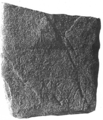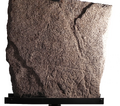VB·23
| Inscription | |
|---|---|
| Reading in transliteration: | kiketụ / ṛẹṭalos |
| Reading in original script: | |
|
| |
| Object: | VB·23 Stresa (stela) |
| Position: | front |
| Orientation: | 350° |
| Frame: | |
| Direction of writing: | dextroverse |
| Script: | North Italic script (Lepontic alphabet) |
| Letter height: | 4.5–6 cm1.772 in <br />2.362 in <br /> |
| Number of letters: | 13 |
| Number of words: | 2 |
| Number of lines: | 2 |
| Workmanship: | carved |
| Condition: | damaged |
|
| |
| Archaeological culture: | La Tène D 2 [from object] |
| Date of inscription: | 1st c. BC [from object] |
|
| |
| Type: | funerary |
| Language: | Celtic |
| Meaning: | 'Kiketu son of Retos' (?) |
|
| |
| Alternative sigla: | Tibiletti Bruno 1981: 15 Solinas 1995: 121 Morandi 2004: 66 |
|
| |
| Sources: | Morandi 2004: 564 no. 66 |
Images
Commentary
First published in De Giuli 1979: 247. Examined for LexLep on 20th April 2024.
Images in De Giuli 1979: 247 (photo fig. 2 = Mainardis 2009: 337, fig. 5, and drawing), Tibiletti Bruno 1979: 259, fig. 3 (drawing), Caramella & De Giuli 1993: 207 (drawing).
Inscribed on what is today the lower area of the slab, at ca. 53 cm distance from the top edge; the stone's original shape being unknown, it is not clear how the inscription was situated originally. It is written dextroverse in two left-aligned, slightly slanting lines (length line 1 28.5 cm, line 2 30.5 cm), which are inscribed in a rectangular frame. On the difficult reading see in detail Tibiletti Bruno 1979: 257. Though the inscription is damaged, the letters identified by Tibiletti can be identified reasonably well. Final, inverted upsilon in line 1 is damaged by a break along the second hasta; the surface around epsilon and St. Andrew's cross in line 2 is damaged by splintering, but the hasta and maybe the upper and lower bar of epsilon as well as the upper part of St. Andrew's cross are faintly visible.
Tibiletti Bruno 1979: 257–260 interprets retalos as a patronym in -al-, pointing to the late appearance of the suffix in NO·18 (Miasino) (thus also Tibiletti Bruno 1981: 167 f., no. 15, , Caramella & De Giuli 1993: 207 f., Solinas 1995: 372, no. 121, Morandi 2004: 564, no. 66). Differently Markey & Mees 2003: 139, who appear to regard kiketu as a patronym in -ū (see The Cisalpine Celtic Languages).
See the object page on the dating; VB·23 may belong to the oldest layer of gravestones from the Verbano based on the stone shape and frame, grammar, and the use of the Lepontic alphabet without evident Latin influence.
See also Tibiletti Bruno 1978c: 24 f.
Bibliography
| Caramella & De Giuli 1993 | Pierangelo Caramella, Alberto De Giuli, Archeologia dell'Alto Novarese, Mergozzo: Antiquarium Mergozzo 1993. |
|---|---|
| De Giuli 1978 | Alberto De Giuli, "Le stele funerarie di Brisino", Bollettino Storico per la Provincia di Novara 69/1 (1978), 13–20. |
| De Giuli 1979 | Alberto De Giuli, "Le stele funerarie di Brisino", Sibrium 14 (1978–1979), 245–252. |
| De Hoz 1990 | Javier de Hoz, "El genitivo celtico de los temas en -o-", in: Francisco Villar (ed.), Studia indogermanica et palaeohispanica in honorem Antonio Tovar et Luis Michelena, Salamanca: Ediciones Universidad de Salamanca 1990, 315–329. |



